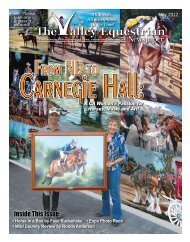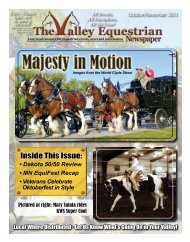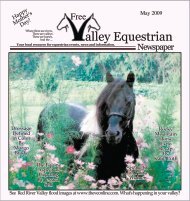August 2008 - The Valley Equestrian Newspaper
August 2008 - The Valley Equestrian Newspaper
August 2008 - The Valley Equestrian Newspaper
You also want an ePaper? Increase the reach of your titles
YUMPU automatically turns print PDFs into web optimized ePapers that Google loves.
<strong>The</strong> <strong>Valley</strong> <strong>Equestrian</strong> Page 8 www.theveonline.com<br />
By Dan Drewlow<br />
Weaning Advice from the Breeder<br />
Q) I have my first foal this year and I am wondering<br />
how do I wean him<br />
A) <strong>The</strong>re are two primary opinions when it comes<br />
to weaning the foal from its dam: Abrupt Separation<br />
and Gradual Separation.<br />
Abrupt separation is where the foal or dam is<br />
taken as far away from each other as possible, preferably<br />
where they are out of eyesight and earshot<br />
of each other. It’s always better to move the dam<br />
instead of the foal to lessen the amount of stress on<br />
the foal about being in a new environment.<br />
Gradual separation is where the foal or dam<br />
is kept in a next door paddock/stall and they are<br />
permitted to visit each other daily for increasingly<br />
shorter periods of time until they are eventually<br />
permanently separated.<br />
<strong>The</strong> method that I prefer to use is a mixture<br />
of gradual and abrupt. I like the abrupt method<br />
as I feel strongly that once the mare and foal are<br />
separated that they should stay that way. I like the<br />
gradual method to lessen the stress on the foal and<br />
the dam as they can still see, hear, and touch each<br />
other. <strong>The</strong> method that I like to use and believe<br />
provides the best results, in most cases, is to move<br />
the dam to a stall next to the foal. That way the foal<br />
and dam have less stress as they can see, hear, and<br />
touch each other. <strong>The</strong> abrupt part is that once they<br />
are separated they stay that way so that the foal can<br />
not nurse off the mare. In most cases I have found<br />
this to be the least stressful and most successful way<br />
to wean.<br />
<strong>The</strong> other important part of any weaning is your<br />
facilities and the amount of foals to be weaned.<br />
Without sufficient acreage the abrupt method<br />
doesn't work well. <strong>The</strong> dam and foal will continue<br />
to stress as long as they can hear each other without<br />
being able to see each other. Also if you are weaning<br />
a large group of foals and don't have stalls or<br />
paddocks for gradual separation but you have the<br />
acreage then the abrupt method may be best.<br />
It doesn't matter what type of weaning process<br />
that you use; I always remind people to thoroughly<br />
inspect the area that the foal is going to be during<br />
the weaning process. You need to make sure your<br />
facilities are safe. <strong>The</strong>re should be no loose boards<br />
or sharp items in the paddock or stall. <strong>The</strong> fences<br />
and gates should be safe and at the proper height in<br />
the pastures. Whether the foal is weaned in a stall<br />
or out in a pasture you need to make sure everything<br />
is safe. Since the foal will be fretting over the<br />
new situation, it’s a susceptible time for an injury to<br />
occur.<br />
J & S Farmer’s Mill<br />
104 5th Avenue SE<br />
Barnesville, MN 56514<br />
218.354.2247<br />
Toll Free: 1.877.521.0150<br />
Home: 218.493.4574<br />
Jim & Sue Heng, Owners<br />
Quality Feed<br />
Pays Off!<br />
See Jim for all your<br />
horse feed!<br />
<strong>August</strong> <strong>2008</strong> <strong>The</strong> <strong>Valley</strong> <strong>Equestrian</strong> Page 9 www.theveonline.com<br />
By Amber Voigt<br />
<strong>The</strong> Medora Cowboy and<br />
His Horse<br />
While vacationing this year in Medora, North Dakota<br />
with my future husband, we ran into a familiar<br />
face of the west. <strong>The</strong> world knows him as Cowboy<br />
Lyle, Medora’s famous cowboy. It all started when I<br />
wanted to attend Cowboy Lyle’s daily presentation<br />
at 11 a.m. by the Chuck Wagon Café. My significant<br />
other tried his best to convince me it was too early<br />
to do something at 11 a.m. when you are on vacation.<br />
Being a horse rancher all my life, 11 a.m. is not<br />
early by any means. And although he tried his best<br />
to refuse, at 11 a.m. we were there in the third row.<br />
<strong>The</strong> presentation<br />
was on the proper<br />
way to catch, saddle,<br />
bridle, mount,<br />
and dismount a<br />
horse. Although the<br />
presentation was<br />
very knowledgeable<br />
and enjoyable, the<br />
real kicker was the<br />
life stories that went<br />
with it. Every cowboy<br />
has a story for<br />
every step in life,<br />
and Cowboy Lyle is<br />
no exception.<br />
Cowboy Lyle told<br />
of his work on an<br />
Arabian breeding<br />
ranch before his<br />
days in Medora,<br />
and of how he came<br />
to be in Medora. But<br />
what really got me<br />
was the things most<br />
don’t expect about<br />
a person. I have been around cowboys all my life<br />
and what you see is what you get most of the time.<br />
<strong>The</strong>re is always an exception and Cowboy Lyle is<br />
one of them. Cowboy Lyle started his life in<br />
Minnesota, and got his first horse as a child. His<br />
parents bought the yearling mare for their children<br />
hoping they could all grow up together. When the<br />
mare turned three and it was time to start riding<br />
her, Lyle was the only one to take interest in doing<br />
the job. Although there were many spills, after a<br />
few years Lyle and the mare became great partners.<br />
Growing up, Lyle was a true cowboy at heart,<br />
and attended college at Crookston, Minn. taking<br />
classes in horsemanship. After college, Lyle had<br />
a hard time finding a job in this field, until an old<br />
boss and friend told him to apply for the stable<br />
manager’s position in Medora, No. Dak. To Lyle’s<br />
satisfaction he was offered the job, and began his<br />
life in Medora.<br />
When the <strong>The</strong>odore Roosevelt Medora Foundation<br />
wanted to bring the old west back into their<br />
town, Lyle once more was given a great opportunity.<br />
As part of this new position, he was to ride<br />
around town on horseback and talk to people,<br />
drive the team and wagon, and give instructional<br />
presentations on horsemanship. Thus, Lyle became<br />
the famous Cowboy Lyle.<br />
As Cowboy Lyle became more involved in Medora<br />
and with the Foundation his daily schedule grew.<br />
He soon was in the Medora Musical, riding horse<br />
and driving the buggy. He was asked to act in the<br />
musical, and through the years he has been thrown<br />
threw bar room windows, in gun shoot-outs, and as<br />
been extras in various other scenes. This year Cowboy<br />
Lyle is one of the Canadian Mounties, the BBQ<br />
cook, and the wagon driver. He is in photo shoots<br />
and commercials for Medora and the Foundation.<br />
And where would a cowboy be without his<br />
horse Cowboy Lyle and his boss went to Billings,<br />
Mont. to the sale barn looking for some good trail<br />
horses when Lyle saw the three-year-old black and<br />
white paint being unloaded. Cowboy Lyle took a<br />
great liking to the<br />
horse and told his<br />
boss to take a look.<br />
<strong>The</strong> Foundation was<br />
looking for a flashy<br />
horse for Cowboy<br />
Lyle to ride around<br />
town and give<br />
presentations on. So<br />
with some haggling,<br />
Cowboy Lyle had<br />
himself a horse.<br />
And you can see<br />
Cowboy Lyle and<br />
Chocolate all summer<br />
in Medora. <strong>The</strong><br />
now seven-year-old<br />
horse loves attention<br />
from the children<br />
on the street and in<br />
turn the kids get a<br />
kick out of a horse<br />
named after candy.<br />
So next time you<br />
visit Medora, and<br />
take in the musical,<br />
National Park,<br />
golf, shops, and its marvelous beauty -- don’t miss<br />
Cowboy Lyle and Chocolate. Even in the Medora<br />
commercials they are the horse and rider walking<br />
off into the colorful sunset of the Medora buttes.<br />
Medora's Cowboy Lyle with Chocolate thrills visitors to the <strong>The</strong>odore<br />
Roosevelt National Park in Medora. Photo by Amber Voigt<br />
For more information on making a donation or<br />
volunteer opportunities contact us at:<br />
(218) 359-0007<br />
ExecdirectorROAW@aol.com<br />
www.ridingonangelswings.org<br />
<strong>August</strong> <strong>2008</strong><br />
<strong>2008</strong> Cowboy HALL OF<br />
FAME INDUCTEES NAMED<br />
<strong>The</strong> 200 Trustees of the North Dakota Cowboy<br />
Hall of Fame (NDCHF) have selected six individuals,<br />
one historic ranch and one rodeo bucking horse<br />
for their Hall of Honorees in Medora. <strong>The</strong> actual<br />
induction of the eight new honorees will take place<br />
in Medora on Saturday, <strong>August</strong> 2, beginning at<br />
12:00 p.m. MDT.<br />
NDCHF Executive Director Darrell Dorgan says<br />
the <strong>2008</strong> inductees will join the more than 100 others<br />
who have been inducted since 1998. He notes<br />
this year’s inductees come from: Grant, Morton,<br />
Dunn, McLean counties and the Fort Berthold<br />
Reservation.<br />
<strong>The</strong> <strong>2008</strong> nominees include:<br />
Pre-1940 Rodeo:<br />
George Charging, of McLean and Dunn counties<br />
and the Fort Berthold Reservation, was born in<br />
1893. At age 17, he was hired to ride the range on<br />
the Fort Berthold Reservation Big Lease. He competed<br />
in rodeos across North Dakota in calf roping<br />
and, in later years, provided stock for the Minot<br />
State Fair Rodeo.<br />
Charging’s ranching endeavors did not permit him<br />
to travel very far to participate in rodeo competitions.<br />
Always the cowboy, Charging rode many<br />
miles to assist other ranchers during round ups and<br />
brandings where his roping skills were invaluable.<br />
He was active in his local church council, and the<br />
Fort Berthold Tribal Council. He and his wife raised<br />
a family of six children, and he died in 1952.<br />
Modern-era Rodeo<br />
Mervel Raymond Hall, of Elbowoods, Mandaree<br />
and Fort Berthold, was born on the family ranch<br />
near Elbowoods in 1928 and grew up on horseback.<br />
Hall has ranched and farmed near Mandaree since<br />
1948. <strong>The</strong> NDRA named him Champion Bareback<br />
Rider in 1958 and 1964, Champion Saddle Bronc<br />
Rider in 1958 and All-around Cowboy in 1964. Hall<br />
participated in three events (saddle bronc, bareback<br />
and bull riding) in rodeos from Fort Worth to Denver<br />
to Tucson. He liked to win saddles at rodeos<br />
around home and found time for the Great Plains<br />
Indian Rodeo Association events, too. He was a major<br />
competitor in events from Amidon to Wing and<br />
from Fort Worth to Tucson from 1951 to 1967.<br />
Pre-1940 Ranching<br />
William Connolly of Dunn County was born in 1861<br />
on his family’s homestead in Minnesota. His ranching<br />
operations in North Dakota began in the1880s<br />
near the Killdeer Mountains. In 1886, he bought the<br />
ranch his grandson now lives on in Dunn County.<br />
In 1890, Connolly registered the first cattle brand<br />
with the new state of North Dakota. In the 1890s,<br />
he brought the first registered Hereford bulls from<br />
Chicago, and they became the foundation of his<br />
cattle empire. Connolly bred English thoroughbred<br />
studs with Percheron mares and sold the draft<br />
crosses in the Red River <strong>Valley</strong> and Iowa. He was<br />
a charter member of the North Dakota Stockmen’s<br />
Association and the fifth person from North Dakota<br />
to be inducted into the National Cowboy Hall of<br />
Fame in Oklahoma City. He died in 1946.<br />
Cowboy Hall of Fame Inductees continued<br />
on page 19








